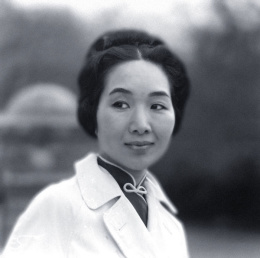By: Albert Serrano | Date Added:

Michiko Nishiura Weglyn was born in Stockton, California, on November 29, 1926, the eldest of two daughters of Tomojiro and Misao Nishiura. Her father had immigrated from Japan in 1916, and his picture bride wife, Misao Yuwasa Nishiura, came to the US in 1922. They lived and worked alongside Misao's family members as tenant farmers in Brentwood, California. They leased land to raise fruits and vegetables, including cantaloupes, tomatoes, cucumbers, and apricots, in the San Joaquin Valley. An exceptional student while attending Liberty Union High School in Brentwood, Weglyn received a citizenship award from the American Legion in 1940 and won first prize from the Rotary Club for an essay on the U.S. Constitution. After the war broke out, the Nishiura family was forcibly removed from their home in Brentwood, first to the Turlock Assembly Center in May 1942, and then in August, to the euphemistically named Gila River Relocation Center. She remembers traveling two days and nights to reach the isolated desert enclave in Arizona, where they were assigned an end room in Block 66, Barrack 12, among roughly 13,000 other inmates, and where the family spent the next three years. The teenage Michi and her sister Tomi attended Butte High School. Among Weglyn's many activities were organizing and leading a Girl Scout troop and winning essay and oratorical contests as president of the Forensics League. As Girls League president, she led the effort to sponsor a day-long Girls League Convention at the camp, drawing more than five hundred girls from throughout Arizona. After graduating from Butte High School in 1944, with the encouragement of a committed English teacher, Mabel Sheldon, Weglyn was accepted to Mt. Holyoke College in Massachusetts. With the help of the National Japanese American Student Relocation Council, she received a full scholarship and went on to major in biology. Winning an award for a set design she created for a college stage production prompted her interest in set and costume design. In December 1945, about with tuberculosis forced her into treatment at the Glen Gardner Sanatorium in New Jersey, and she had to subsequently withdraw from college without a diploma. After a brief period with her own costume rental and manufacturing company, Weglyn embarked on a seven-year research project that led to the publication of Years of Infamy. With encouragement from her husband Walter and influenced by the 1960s civil rights movement, she wanted to set the record straight about the causes of the WWII incarceration and relieve the guilt felt by many of her Nisei peers. Working with primary documents she uncovered at the National Archives, the Franklin Roosevelt Library, and the New York City Library, Weglyn pieced together the dramatic story of how the incarceration came to be—not as the result of "military necessity," as claimed by the Roosevelt Administration, but because of racial prejudice and governmental blunder. She recounted in detail the findings of the Munson Report, which found that Japanese Americans living in the U.S. presented little security risk in the event of war with Japan. Commissioned by Roosevelt himself, it was compiled by a White House special investigator Curtis B. Munson but largely ignored in the days leading up to Executive Order 9066. Released to critical acclaim in 1975, Years of Infamy was hailed by Japanese American activists, most notably Edison Uno as providing the necessary evidence for the subsequent decades-long battle for redress and reparation, and was coined the "Bible of the Redress Movement." In the years following its publication, Weglyn continued her advocacy for the thousands who had been initially denied redress, including railroad and mine workers fired from their jobs at the behest of the government, and Latin Americans abducted from their native countries. She continued active work on behalf of the Japanese Peruvians until her death from cancer on April 25, 1999. Although never having graduated from college, Weglyn was awarded honorary degrees from Mt. Holyoke College, Hunter College, and California State Polytechnic University at Pomona, the current site of the Michi and Walter Weglyn Endowed Chair for Multicultural Studies.
Share your thoughts on this story with us. Your comments will not be made public.
Email
Copyright ©2016 - Design By Bureau Blank